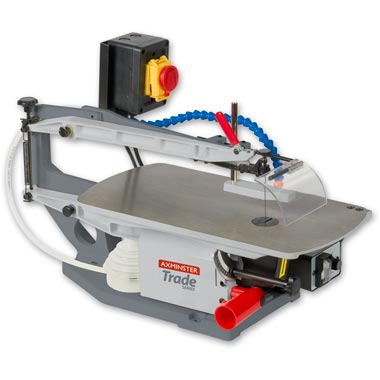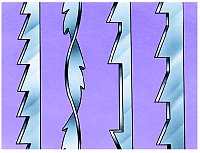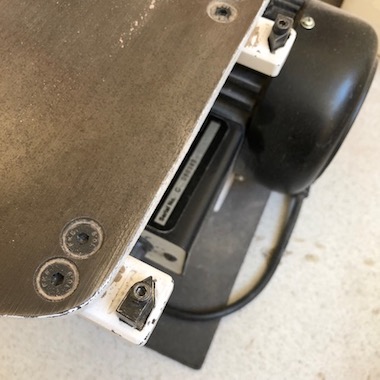Equipment/AxminsterScrollSaw
Class Orange equipment: Only use if you are confident doing so. Training is available if not.
(More about equipment classes)
Contents
Summary
A scroll saw is a small electric saw that is useful for cutting intricate curves in cases where a jigsaw or coping saw is not appropriate. It is capable of creating curves with edges. It is somewhat similar to a band saw, but unlike band saws, in which the saw blade is a continuous loop, scroll saws use saw blades similar to those of coping saws and operate through a quick reciprocating up and down motion.
A scroll saw has two main advantages when compared to a band saw. The first is that the blade can be removed and placed in situ through a pre-drilled starting hole. This feature allows interior cut-outs to be made without creating an entry slot for the blade through the edge of the workpiece. Second, a scroll saw can cut significantly more intricate curves.
Owners
- Michael Dales
Health and Safety
Sharp Object/material
- Power supply to be disconnected when changing Blades.
- Wait for the blade to stop moving before attempting any adjustments.
Slips, Trips and Falls
- Waste material/offcuts to be kept clear of work area.
Fire
- Equipment will be checked for defects before each use to minimise the risk of possible electrical faults or fire.
- Carbon Dioxide extinguisher to be available for any electrical fires
Electric shock
- The equipment will be checked before each use to ensure that there are no defects in the casing, battery or cutting head.
Sight/Noise/Dust/Vibration
- P.P.E. to be worn when using the equipment.
- Regular brakes to be taken to prevent fingers becoming numb
Repetitive Action/Physical Fatigue
- Regular breaks to be taken if work is lasting more than 5 minutes in duration
Training
No mandatory training is required to use this tool.
Optional training will be available in the near future.
Instructions
The scroll saw is a relatively safe tool to use. if you've never used one, here is a quick introduction video
For detailed instructions se the manual or the saw Scroll Saw Manual
Because of the thin blade, using a scroll saw needs a delicate touch. If you push too hard, you will all too easily snap the blade. To cut a curved shape, feed the work with both hands, holding the wood flat against the saw's base while applying gentle forward pressure. The key is patience. Allow the work to feed through the saw blade slowly, without forcing it. If you begin to feel a greater level of resistance this will probably be due to a blunt blade.
A common mistake is to accidentally exert sideward pressure while feeding the wood through. If this begins to happen, relax the pressure on the wood by lessening the fingertip pressure. However, do not let go of the wood, just relax the pressure.
Blade Selection
Scroll saw blade sizes typically range from 1 to 12. Each blade size is designed to be used with different thicknesses of wood. The smaller the blade you can pick, the easier it is to cut delicate curves. The rough selection is as follows:
Scroll Blades (Shown on the left) are recommended for cutting thicker and harder material.
Spiral Blades (Shown 2nd from the left) blades are twisted so teeth point outward in every direction. A 360° capacity allows cutting in any direction without turning your work.
Reverse Blades (Shown 2nd from right) Teeth are pointed in both directions to give splinter free cutting on the top and bottom.
| Blade size | Hardwood thickness | Softwood Thickness |
|---|---|---|
| 1 to 2 | 1/4" | 1/4" |
| 3 to 4 | 1/2" | 3/4" |
| 5 to 6 | 1/4" to 3/4" | 1/4" to 1" |
| 7 to 9 | 1/4" to 1" | 1/4" to 2" |
| 10 to 12 | 3/4" to 2" | 3/4" to 2" |
Choosing the Right Blade for Your Scroll Saw (Video)
Technical Specification
| Cuts per Minute | 400-1,400 |
| Max Depth of Cut | 65mm |
| Net Weight | 29kg |
| Overall L x W x H | 620 x 285 x 310mm |
| Power | 120W |
| Rating | Trade |
| Stroke | 10 & 20mm |
| Table Size | 460 x 235mm |
| Table Tilt | 0-45° |
| Throat | 460mm(18") |
Tips & Tricks
- You must guide the wood into the blade SLOWLY, because the teeth are very small, and cut ONLY on the down stroke. If you push the wood into the blade too rapidly, you can easily break the blade.
- The teeth on the blade will wear out sooner or later. The blade must therefore be replaced often to obtain the best cutting results. A blade will stay sharp for half an hour to 2 hours of continuous running, depending on the material being cut.
- Be aware that the blade has a tendency to follow the grain of the wood. You can compensate for this by watching the grain carefully and guiding the wood past the saw blade.
- There is a jig and guide on the near right hand side of the bed to help you mount a blade in the bits. See picture to show where.
Maintenance
Every month inspect for damage and general wear and tear and asses state of stock blades and replace as needed.
Replacement blades Scroll Saw Blade Mixed Pack (60 blades) £15


